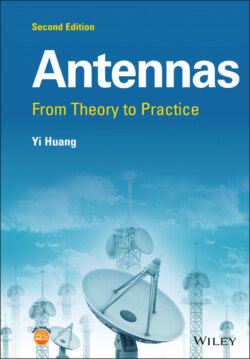Читать книгу Antennas - Yi Huang - Страница 18
1.3.2 Vectors and Vector Operation
ОглавлениеA scalar is a one‐dimensional quantity that has magnitude only, whereas a complex number is a two‐dimensional quantity. A vector can be viewed as a three‐dimensional (3D) quantity, and a special one – it has both a magnitude and a direction. For example, force and velocity are vectors. A position in space is a 3D quantity, but it does not have a direction, thus it is not a vector. Figure 1.7 is an illustration of vector A in Cartesian coordinates. It has three orthogonal components (Ax, Ay, Az) along the x, y, and z directions, respectively. To distinguish vectors from scalars, the letter representing the vector is printed in bold, as A or a, and a unit vector is printed in bold with a hat over the letter as or .
Figure 1.7 Vector A in Cartesian coordinates
The magnitude of vector A is given by
(1.6)
Now let us consider two vectors A and B:
The addition and subtraction of vectors can be expressed as
(1.7)
Obviously, the addition obeys the commutative law, that is A + B = B + A.
Figure 1.8 shows what the addition and subtraction mean geometrically. A vector may be multiplied or divided by a scalar. The magnitude changes but its direction remains the same. However, the multiplication of two vectors is complicated. There are two types of multiplication: dot product and cross product.
Figure 1.8 Vector addition and subtraction
The dot product of two vectors is defined as
(1.8)
where θ is the angle between vector A and vector B and cos θ is also called the direction cosine. The dot • between A and B indicates the dot product that results in a scalar, thus it is also called a scalar product. If the angle θ is zero, A and B are in parallel – the dot product maximized, whereas for an angle of 90 degrees, i.e. when A and B are orthogonal, the dot product is zero.
It is worth noting that the dot product obeys the commutative law, that is, A • B = B • A.
The cross product of two vectors is defined as
(1.9)
where is a unit vector normal to the plane containing A and B. The cross × between A and B indicates the cross product that results in a vector C, thus, it is also called a vector product. The vector C is orthogonal to both A and B, and the direction of C follows a so‐called right‐hand rule as shown in Figure 1.9. If the angle θ is zero or 180 degrees, that is, A and B are in parallel, the cross product is zero, whereas for an angle of 90 degrees, i.e. A and B are orthogonal, the cross product of these two vectors reaches a maximum. Unlike the dot product, the cross product does not obey the commutative law.
Figure 1.9 The cross product of vectors A and B
The cross product may be expressed in determinant form as follows, which is the same as Equation (1.9) but it may be easier for some people to memorize:
(1.10)
Another important thing about vectors is that any vector can be decomposed into three orthogonal components (such as x, y, and z components) in 3D or two orthogonal components in a 2D plane.
